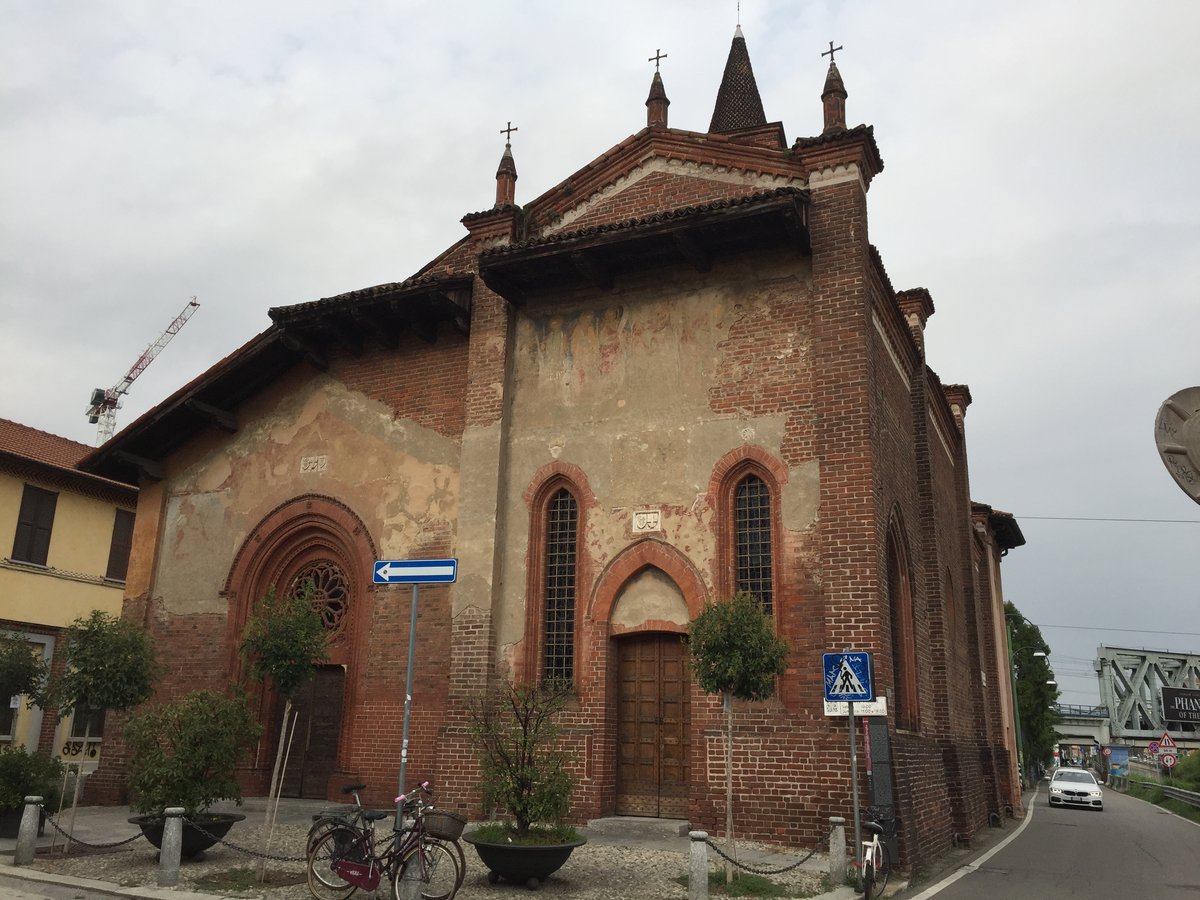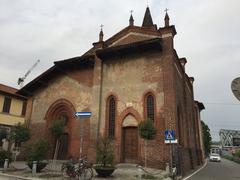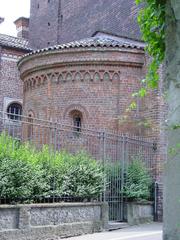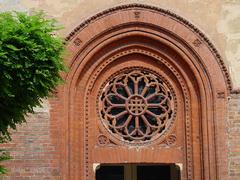
San Cristoforo Sul Naviglio Church: Visiting Hours, Tickets, and Milan Historical Sites Guide
Date: 14/06/2025
Introduction
San Cristoforo sul Naviglio is one of Milan’s most evocative historical landmarks, standing majestically along the Naviglio Grande canal. Celebrated for its rare double-church structure and an extraordinary blend of Romanesque, Gothic, and Renaissance architecture, this destination offers a window into Milan’s religious and urban evolution. This comprehensive guide explores the church’s layered history, artistic treasures, and enduring cultural significance, while providing essential information on visiting hours, tickets, accessibility, and travel tips for an enriching Milanese experience (Chiesa San Cristoforo; Lombardia Beni Culturali; YesMilano).
Table of Contents
- Origins and Historical Development
- Artistic and Architectural Highlights
- Cultural Significance and Local Traditions
- Visiting Information: Hours, Tickets, Accessibility
- Nearby Attractions and Visitor Tips
- Frequently Asked Questions (FAQ)
- Conclusion
- Sources
Origins and Historical Development
Early Roots and Strategic Location
With origins dating back to at least the late 12th century, San Cristoforo sul Naviglio is deeply intertwined with Milan’s history as a hub for pilgrims, merchants, and travelers. Its location along the Naviglio Grande—a vital medieval trade and pilgrimage route—made it a sanctuary for those journeying into the city (chiesasancristoforo.it). Some sources suggest that the site may have first hosted a Roman or pagan temple, later Christianized and dedicated to Saint Christopher, the patron of travelers.
Medieval and Visconti Transformations
The church’s original Romanesque oratory was reconstructed after 1192, and its importance grew during Milan’s medieval period. In the late 14th century, following a devastating plague, Gian Galeazzo Visconti, the Duke of Milan, commissioned the Cappella Ducale as an act of thanksgiving. This new chapel, featuring the Visconti family’s heraldic emblems, transformed the church into a dynastic and civic symbol. By the 15th century, the structure had expanded into a “double church,” with two naves side by side: the older Romanesque oratory and the newer Gothic chapel.
Later Developments
In 1625, the two churches were physically joined by removing the dividing wall, creating the unified yet historically stratified space we see today. The adjacent hospital, founded in the 14th century, underscored the church’s enduring role as a refuge for travelers and the sick (Divina Milano; Tiraccontounviaggio).
Artistic and Architectural Highlights
Unique Double Church Structure
San Cristoforo sul Naviglio’s most distinctive feature is its double church layout—a rare architectural solution in Milan. The two naves, aligned along a single façade, reflect stylistic evolution from Romanesque simplicity to ornate Gothic and Renaissance elements (Lombardia Beni Culturali; Wikipedia).
- Left Nave: Romanesque origins, featuring a semi-gabled façade, wooden ceiling, and semicircular apse.
- Right Nave (Cappella Ducale): Gothic style commissioned by the Visconti, with pointed arches, terracotta decorations, and ribbed vaults.
Bell Tower and Façade
The slender, 15th-century brick campanile, known locally as the “faro meneghino,” rises as a beacon along the canal. The façade combines Romanesque simplicity with Gothic ornamentation, including a terracotta portal and rose window. The portal is adorned with the Visconti serpent, symbolizing Milan’s medieval rulers (Milano da Vedere).
Frescoes and Artistic Treasures
Inside, visitors will find remarkable frescoes dating to the early 15th century:
- Zavattari Brothers: Crucifixion scenes and devotional figures, also known for their work in the Duomo of Monza.
- School of Bergognone: Soft color palettes and serene religious themes.
- Bassanolo de’ Magistris: Madonna and Saints, as well as a Crucifixion attributed to this notable Lombard artist (MilanoGuida).
Despite challenges posed by canal humidity, many of these frescoes are preserved and visible. The Cappella Ducale also features stained glass windows and Renaissance-era wooden statues, adding to the church’s intimate devotional atmosphere.
Heraldic and Symbolic Elements
The church’s exterior and interior display the Visconti “biscione,” Milan’s red cross, and other heraldic symbols, underscoring its ties to the city’s ruling elite and its role as a civic protector (Milano da Vedere).
Cultural Significance and Local Traditions
Saint Christopher: Patron of Travelers
San Cristoforo has long been seen as the guardian of those journeying by land or water. The church’s riverside setting made it a crucial blessing site for departing crusaders and later travelers. Today, the annual festival on July 25th honors Saint Christopher with processions and open-air celebrations, blending religious devotion with Milanese social life (Divina Milano).
Social and Charitable Role
Historically, San Cristoforo served as a hospital and lazzaretto during plague outbreaks, and as a center for religious confraternities managing charitable activities. It remains a popular site for weddings, baptisms, and community gatherings.
Integration with Navigli District
The surrounding Navigli neighborhood, once industrial and now a creative hub, is famous for its canals, artisan workshops, and vibrant nightlife. The church’s presence anchors the district’s identity, blending sacred tradition with contemporary art—visible in modern murals and street art nearby (Tiraccontounviaggio; Milantips).
Visiting Information: Hours, Tickets, Accessibility
Opening Hours
- Standard Hours: Daily, 9:00 AM to 6:00 PM (may vary during holidays, special events, or religious services).
- Recommendation: Check the official website for the latest updates on opening times.
Tickets and Entry
- Admission: Free for all visitors.
- Guided Tours: Available on request, often through local cultural associations or tour operators. Booking in advance is recommended for in-depth tours.
Accessibility
- Wheelchair Access: The church has ramps and accessible restrooms; visitors with mobility needs are advised to contact in advance.
- Public Transport: Reachable via Metro Line 2 (Porta Genova), tram lines 2 and 14, or on foot/cycle along the Naviglio Grande.
- Parking: Limited street parking available; cycling is encouraged due to the canal-side bike path.
Photography and Etiquette
- Photography: Permitted inside, respectfully. Avoid flash and tripods to protect artworks.
- Dress Code: Modest attire is customary in Italian churches.
Nearby Attractions and Visitor Tips
- Naviglio Grande: Stroll the canal, lined with cafes, galleries, and artisan shops.
- Porta Genova: Historic city gate and access point to the Navigli district.
- Basilica di Sant’Eustorgio: Notable for its medieval art and chapels.
- MUDEC (Museum of Cultures): Explore Milan’s diverse cultural heritage.
- Darsena and Vicolo dei Lavandai: Picturesque canal-side landmarks.
Tips:
- Visit early morning or late afternoon for tranquil atmosphere and optimal photos.
- Combine your church visit with a meal or aperitivo along the canal.
- Check for special events or festivals, especially in summer.
Frequently Asked Questions (FAQ)
Q: What are the visiting hours for San Cristoforo sul Naviglio?
A: Daily, 9:00 AM to 6:00 PM. Confirm on the official website for holiday or event changes.
Q: Is there an entrance fee?
A: No, entry is free.
Q: Are guided tours available?
A: Yes, by reservation through the official website or local tour operators.
Q: Is the church accessible for people with disabilities?
A: Yes, with ramps and accessible facilities.
Q: How do I get there by public transport?
A: Metro Line 2 (Porta Genova), tram lines 2 and 14, or by bike along the canal.
Q: What else can I visit nearby?
A: Naviglio Grande, Porta Genova, Basilica di Sant’Eustorgio, MUDEC, and the vibrant Navigli district.
Conclusion
San Cristoforo sul Naviglio is a living testament to Milan’s religious, architectural, and communal heritage. Its unique double church structure, exquisite frescoes, and riverside setting make it a must-visit for anyone exploring Milan’s historical sites. Whether you seek history, art, or a quiet place for reflection, San Cristoforo sul Naviglio offers a memorable and meaningful experience. Plan your visit, explore the surrounding Navigli district, and immerse yourself in the rich tapestry of Milanese culture.
For up-to-date information on visiting hours, events, and guided tours, consult the official church website and trusted Milan tourism platforms. Enhance your exploration by downloading the Audiala app for audio guides and travel tips, and follow us on social media for the latest news and visitor advice.
Sources and Further Reading
- San Cristoforo sul Naviglio: A Historical Milanese Treasure and Visitor’s Guide, 2024
- San Cristoforo sul Naviglio: Visiting Hours, Tickets, and Milan’s Historic Double Church, 2024
- San Cristoforo sul Naviglio: Visiting Hours, Tickets, and Exploring One of Milan’s Most Historic Sites, 2024
- San Cristoforo sul Naviglio Visiting Hours & Tickets | Milan Historical Sites Guide, 2024






























































